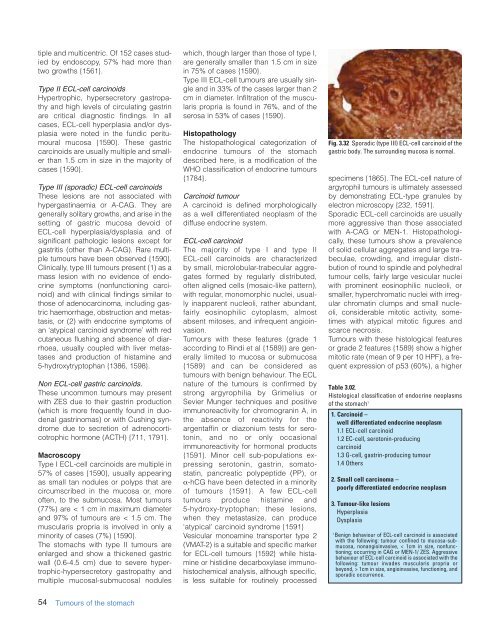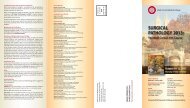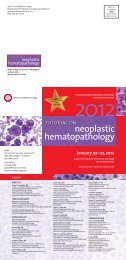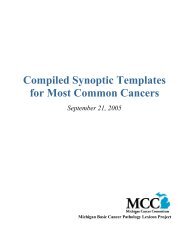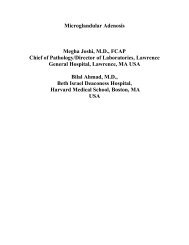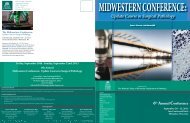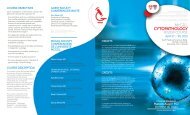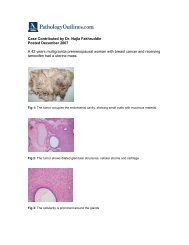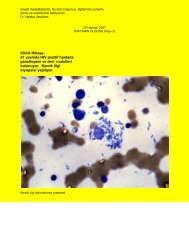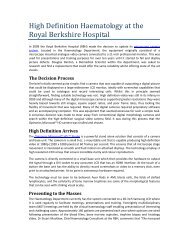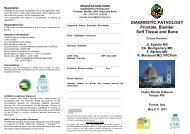CHAPTER 3 Tumours of the Stomach - Pathology Outlines
CHAPTER 3 Tumours of the Stomach - Pathology Outlines
CHAPTER 3 Tumours of the Stomach - Pathology Outlines
You also want an ePaper? Increase the reach of your titles
YUMPU automatically turns print PDFs into web optimized ePapers that Google loves.
tiple and multicentric. Of 152 cases studied<br />
by endoscopy, 57% had more than<br />
two growths {1561}.<br />
Type II ECL-cell carcinoids<br />
Hypertrophic, hypersecretory gastropathy<br />
and high levels <strong>of</strong> circulating gastrin<br />
are critical diagnostic findings. In all<br />
cases, ECL-cell hyperplasia and/or dysplasia<br />
were noted in <strong>the</strong> fundic peritumoural<br />
mucosa {1590}. These gastric<br />
carcinoids are usually multiple and smaller<br />
than 1.5 cm in size in <strong>the</strong> majority <strong>of</strong><br />
cases {1590}.<br />
Type III (sporadic) ECL-cell carcinoids<br />
These lesions are not associated with<br />
hypergastinaemia or A-CAG. They are<br />
generally solitary growths, and arise in <strong>the</strong><br />
setting <strong>of</strong> gastric mucosa devoid <strong>of</strong><br />
ECL-cell hyperplasia/dysplasia and <strong>of</strong><br />
significant pathologic lesions except for<br />
gastritis (o<strong>the</strong>r than A-CAG). Rare multiple<br />
tumours have been observed {1590}.<br />
Clinically, type III tumours present (1) as a<br />
mass lesion with no evidence <strong>of</strong> endocrine<br />
symptoms (nonfunctioning carcinoid)<br />
and with clinical findings similar to<br />
those <strong>of</strong> adenocarcinoma, including gastric<br />
haemorrhage, obstruction and metastasis,<br />
or (2) with endocrine symptoms <strong>of</strong><br />
an ‘atypical carcinoid syndrome’ with red<br />
cutaneous flushing and absence <strong>of</strong> diarrhoea,<br />
usually coupled with liver metastases<br />
and production <strong>of</strong> histamine and<br />
5-hydroxytryptophan {1386, 1598}.<br />
Non ECL-cell gastric carcinoids.<br />
These uncommon tumours may present<br />
with ZES due to <strong>the</strong>ir gastrin production<br />
(which is more frequently found in duodenal<br />
gastrinomas) or with Cushing syndrome<br />
due to secretion <strong>of</strong> adrenocorticotrophic<br />
hormone (ACTH) {711, 1791}.<br />
Macroscopy<br />
Type I ECL-cell carcinoids are multiple in<br />
57% <strong>of</strong> cases {1590}, usually appearing<br />
as small tan nodules or polyps that are<br />
circumscribed in <strong>the</strong> mucosa or, more<br />
<strong>of</strong>ten, to <strong>the</strong> submucosa. Most tumours<br />
(77%) are < 1 cm in maximum diameter<br />
and 97% <strong>of</strong> tumours are < 1.5 cm. The<br />
muscularis propria is involved in only a<br />
minority <strong>of</strong> cases (7%) {1590}.<br />
The stomachs with type II tumours are<br />
enlarged and show a thickened gastric<br />
wall (0.6-4.5 cm) due to severe hypertrophic-hypersecretory<br />
gastropathy and<br />
multiple mucosal-submucosal nodules<br />
which, though larger than those <strong>of</strong> type I,<br />
are generally smaller than 1.5 cm in size<br />
in 75% <strong>of</strong> cases {1590}.<br />
Type III ECL-cell tumours are usually single<br />
and in 33% <strong>of</strong> <strong>the</strong> cases larger than 2<br />
cm in diameter. Infiltration <strong>of</strong> <strong>the</strong> muscularis<br />
propria is found in 76%, and <strong>of</strong> <strong>the</strong><br />
serosa in 53% <strong>of</strong> cases {1590}.<br />
Histopathology<br />
The histopathological categorization <strong>of</strong><br />
endocrine tumours <strong>of</strong> <strong>the</strong> stomach<br />
described here, is a modification <strong>of</strong> <strong>the</strong><br />
WHO classification <strong>of</strong> endocrine tumours<br />
{1784}.<br />
Carcinoid tumour<br />
A carcinoid is defined morphologically<br />
as a well differentiated neoplasm <strong>of</strong> <strong>the</strong><br />
diffuse endocrine system.<br />
ECL-cell carcinoid<br />
The majority <strong>of</strong> type I and type II<br />
ECL-cell carcinoids are characterized<br />
by small, microlobular-trabecular aggregates<br />
formed by regularly distributed,<br />
<strong>of</strong>ten aligned cells (mosaic-like pattern),<br />
with regular, monomorphic nuclei, usually<br />
inapparent nucleoli, ra<strong>the</strong>r abundant,<br />
fairly eosinophilic cytoplasm, almost<br />
absent mitoses, and infrequent angioinvasion.<br />
<strong>Tumours</strong> with <strong>the</strong>se features (grade 1<br />
according to Rindi et al {1589}) are generally<br />
limited to mucosa or submucosa<br />
{1589} and can be considered as<br />
tumours with benign behaviour. The ECL<br />
nature <strong>of</strong> <strong>the</strong> tumours is confirmed by<br />
strong argyrophilia by Grimelius or<br />
Sevier Munger techniques and positive<br />
immunoreactivity for chromogranin A, in<br />
<strong>the</strong> absence <strong>of</strong> reactivity for <strong>the</strong><br />
argentaffin or diazonium tests for serotonin,<br />
and no or only occasional<br />
immunoreactivity for hormonal products<br />
{1591}. Minor cell sub-populations expressing<br />
serotonin, gastrin, somatostatin,<br />
pancreatic polypeptide (PP), or<br />
α-hCG have been detected in a minority<br />
<strong>of</strong> tumours {1591}. A few ECL-cell<br />
tumours produce histamine and<br />
5-hydroxy-tryptophan; <strong>the</strong>se lesions,<br />
when <strong>the</strong>y metastasize, can produce<br />
‘atypical’ carcinoid syndrome {1591}<br />
Vesicular monoamine transporter type 2<br />
(VMAT-2) is a suitable and specific marker<br />
for ECL-cell tumours {1592} while histamine<br />
or histidine decarboxylase immunohistochemical<br />
analysis, although specific,<br />
is less suitable for routinely processed<br />
Fig. 3.32 Sporadic (type III) ECL-cell carcinoid <strong>of</strong> <strong>the</strong><br />
gastric body. The surrounding mucosa is normal.<br />
specimens {1865}. The ECL-cell nature <strong>of</strong><br />
argyrophil tumours is ultimately assessed<br />
by demonstrating ECL-type granules by<br />
electron microscopy {232, 1591}.<br />
Sporadic ECL-cell carcinoids are usually<br />
more aggressive than those associated<br />
with A-CAG or MEN-1. Histopathologically,<br />
<strong>the</strong>se tumours show a prevalence<br />
<strong>of</strong> solid cellular aggregates and large trabeculae,<br />
crowding, and irregular distribution<br />
<strong>of</strong> round to spindle and polyhedral<br />
tumour cells, fairly large vesicular nuclei<br />
with prominent eosinophilic nucleoli, or<br />
smaller, hyperchromatic nuclei with irregular<br />
chromatin clumps and small nucleoli,<br />
considerable mitotic activity, sometimes<br />
with atypical mitotic figures and<br />
scarce necrosis.<br />
<strong>Tumours</strong> with <strong>the</strong>se histological features<br />
or grade 2 features {1589} show a higher<br />
mitotic rate (mean <strong>of</strong> 9 per 10 HPF), a frequent<br />
expression <strong>of</strong> p53 (60%), a higher<br />
Table 3.02.<br />
Histological classification <strong>of</strong> endocrine neoplasms<br />
<strong>of</strong> <strong>the</strong> stomach 1<br />
1. Carcinoid –<br />
well differentiated endocrine neoplasm<br />
1.1 ECL-cell carcinoid<br />
1.2 EC-cell, serotonin-producing<br />
carcinoid<br />
1.3 G-cell, gastrin-producing tumour<br />
1.4 O<strong>the</strong>rs<br />
2. Small cell carcinoma –<br />
poorly differentiated endocrine neoplasm<br />
3. Tumour-like lesions<br />
Hyperplasia<br />
Dysplasia<br />
1<br />
Benign behaviour <strong>of</strong> ECL-cell carcinoid is associated<br />
with <strong>the</strong> following: tumour confined to mucosa-submucosa,<br />
nonangioinvasive, < 1cm in size, nonfunctioning;<br />
occurring in CAG or MEN-1/ ZES. Aggressive<br />
behaviour <strong>of</strong> ECL-cell carcinoid is associated with <strong>the</strong><br />
following: tumour invades muscularis propria or<br />
beyond, > 1cm in size, angioinvasive, functioning, and<br />
sporadic occurrence.<br />
54 <strong>Tumours</strong> <strong>of</strong> <strong>the</strong> stomach


